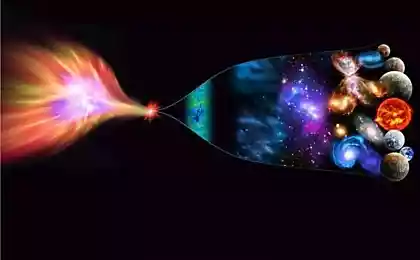483
Something in the internal structure of the Universe escapes the understanding of scientists
Forty two million nine hundred forty seven thousand four hundred ninety one
"We are all looking for something, maybe now some more data that will lead to the moment of truth, says Harry Nelson, a physics Professor at the University of California in Santa Cruz, scientific Director of the updated design, LUX, called LUX-ZEPLIN. The idea that there is something that we're not understanding and do not know gives you shivers".
Scientists have long known that somewhere in space there is dark matter, quietly managing the movement and structure of the Universe. But what really is dark matter? What's it like to its particles? It remains a mystery, and the experiments leave scientists with empty hands: scientists just can't catch these elusive particles. Although regularly appear hints.
With some luck, this situation may change. With a sensitivity of ten times the sensitivity of previous detectors, three recently launched experiment to detect dark matter led scientists to cross my fingers and hope that they will finally be able to catch particles of dark matter. Scientists are working on it, but recognize that the success or failure of their work can determine only the nature.
Last week, studying data collected by the spacecraft XMM-Newton, a team of scientists observed a strange burst of x-rays coming from two different celestial objects — the Andromeda galaxy and the Perseus galactic cluster. A surge does not belong to any known particles or atoms, and so suggestive of dark matter as the source.
"The signal's distribution in the galaxy corresponds exactly to what we expected to see in the case of dark matter, that is, concentrated and intense event in the center of objects and weaker and diffuse on the edges," wrote savorable Oleg Ruchayskiy.
"Nature is modest, says Enectali Figueroa-Feliciano, an associate Professor of physics at mit, working on one of the three new experiments. — There is something in the internal structure of the Universe that we just don't understand. When theorists write out all possible methods of interaction of dark matter with our particles, they come to the conclusion that in the simplest models we were supposed to see her. And if we still found nothing, there is something that is yet to be deciphered".
The first of the new experiments-the Axion Dark Matter eXperimetn, will look for theoretical type of dark matter particle — the axion. ADMX will be looking for evidence that these extremely light particles are converted into photons in a strong magnetic field. Slowly changing magnetic field, the detector will attempt to fix the mass of the axion at the same time.
"We have demonstrated that we have the tools necessary to see axions, said gray Rybka, research associate at Washington University, one of the leaders of the ADMX Gen 2 experiment. With Gen 2, we acquire the powerful, very powerful refrigerator that will arrive very soon. Once it arrives, we will be able to scan very, very quickly and we will have a good chance of finding axions — if they will, of course,".
Two other experiments will be looking for a different type of theoretical dark matter — WIMP, wimpy. Being weakly interacting massive particles, wimpy interact with our world very weakly and very rarely. The experiment is the LUX (Large Underground Xenon), which was launched in 2009, is now in the stage of modernization increases the sensitivity to detect winow. Meanwhile, a collaboration of the Super Cryogenic Dark Matter Search, which searches for signals lightweight winow on its detector since 2013, has already finished a draft of a new experiment, which will be located in Canada.
"In a sense, we are looking for gold, — shared his thoughts Figueroa-Feliciano, a member of the SuperCDMS experiment. — Harry has a pan and he's looking for gold in a deep pond you pond a little smaller, and grey — slightly upstream, digging in his place. We don't know who will buy gold, because we don't know where it is."
Fish agrees, but adds that it is likely that all three experiments will find dark matter. "There is no guarantee that dark matter must consist of one type of particles. Dark matter is one-third may consist of axions, one-third of heavy winow and a third from lung winow. It would be nice to find all the elements".
Only here is a Golden nugget that you are looking for all three experiments, is very expensive. Although the search is difficult, all three scientists agree that it is worth it, because the discovery of dark matter will allow us to revise many things in our Universe.
Source: hi-news.ru
"We are all looking for something, maybe now some more data that will lead to the moment of truth, says Harry Nelson, a physics Professor at the University of California in Santa Cruz, scientific Director of the updated design, LUX, called LUX-ZEPLIN. The idea that there is something that we're not understanding and do not know gives you shivers".
Scientists have long known that somewhere in space there is dark matter, quietly managing the movement and structure of the Universe. But what really is dark matter? What's it like to its particles? It remains a mystery, and the experiments leave scientists with empty hands: scientists just can't catch these elusive particles. Although regularly appear hints.
With some luck, this situation may change. With a sensitivity of ten times the sensitivity of previous detectors, three recently launched experiment to detect dark matter led scientists to cross my fingers and hope that they will finally be able to catch particles of dark matter. Scientists are working on it, but recognize that the success or failure of their work can determine only the nature.
Last week, studying data collected by the spacecraft XMM-Newton, a team of scientists observed a strange burst of x-rays coming from two different celestial objects — the Andromeda galaxy and the Perseus galactic cluster. A surge does not belong to any known particles or atoms, and so suggestive of dark matter as the source.
"The signal's distribution in the galaxy corresponds exactly to what we expected to see in the case of dark matter, that is, concentrated and intense event in the center of objects and weaker and diffuse on the edges," wrote savorable Oleg Ruchayskiy.
"Nature is modest, says Enectali Figueroa-Feliciano, an associate Professor of physics at mit, working on one of the three new experiments. — There is something in the internal structure of the Universe that we just don't understand. When theorists write out all possible methods of interaction of dark matter with our particles, they come to the conclusion that in the simplest models we were supposed to see her. And if we still found nothing, there is something that is yet to be deciphered".
The first of the new experiments-the Axion Dark Matter eXperimetn, will look for theoretical type of dark matter particle — the axion. ADMX will be looking for evidence that these extremely light particles are converted into photons in a strong magnetic field. Slowly changing magnetic field, the detector will attempt to fix the mass of the axion at the same time.
"We have demonstrated that we have the tools necessary to see axions, said gray Rybka, research associate at Washington University, one of the leaders of the ADMX Gen 2 experiment. With Gen 2, we acquire the powerful, very powerful refrigerator that will arrive very soon. Once it arrives, we will be able to scan very, very quickly and we will have a good chance of finding axions — if they will, of course,".
Two other experiments will be looking for a different type of theoretical dark matter — WIMP, wimpy. Being weakly interacting massive particles, wimpy interact with our world very weakly and very rarely. The experiment is the LUX (Large Underground Xenon), which was launched in 2009, is now in the stage of modernization increases the sensitivity to detect winow. Meanwhile, a collaboration of the Super Cryogenic Dark Matter Search, which searches for signals lightweight winow on its detector since 2013, has already finished a draft of a new experiment, which will be located in Canada.
"In a sense, we are looking for gold, — shared his thoughts Figueroa-Feliciano, a member of the SuperCDMS experiment. — Harry has a pan and he's looking for gold in a deep pond you pond a little smaller, and grey — slightly upstream, digging in his place. We don't know who will buy gold, because we don't know where it is."
Fish agrees, but adds that it is likely that all three experiments will find dark matter. "There is no guarantee that dark matter must consist of one type of particles. Dark matter is one-third may consist of axions, one-third of heavy winow and a third from lung winow. It would be nice to find all the elements".
Only here is a Golden nugget that you are looking for all three experiments, is very expensive. Although the search is difficult, all three scientists agree that it is worth it, because the discovery of dark matter will allow us to revise many things in our Universe.
Source: hi-news.ru
The rose hips, a natural immunostimulant
In Iceland, learned to turn carbon emissions to stone. The Project CarbFix























